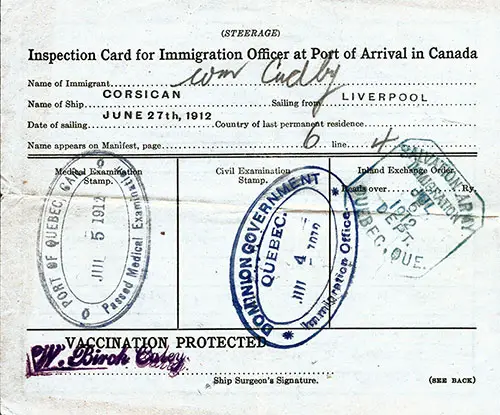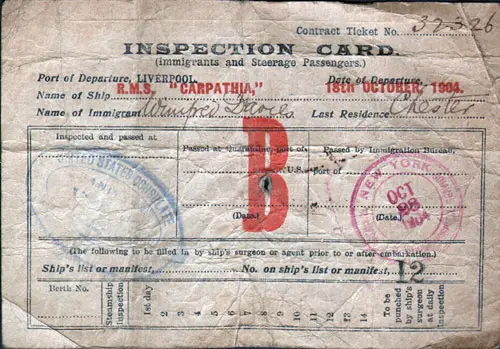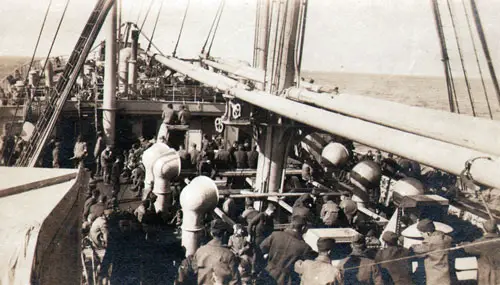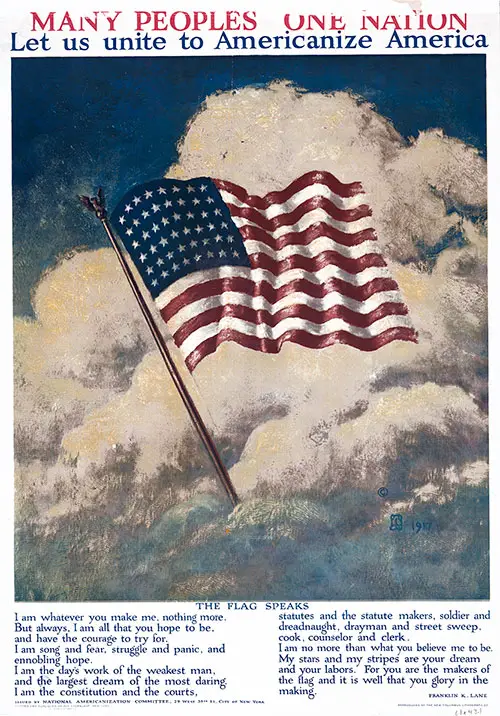US and Canadian Immigration Archival Collection

The GG Archives have essential documents on immigrants' mass migration from primarily European countries to North America. In order of importance, European Immigrants gained access to the United States through the North Atlantic ports of entry: New York, Boston, Philadelphia, and Baltimore.
Through New York at Ellis Island came nearly three-fourths of all our immigrants. Additional information on immigration and the social-economic and other factors are covered under separate topics.
In the earlier passenger ships, a narrow berth to sleep in and a plentiful supply of not over-well-prepared food were afforded. Still, there was little beyond these—notwithstanding the whole ship was given up to first-cabin passengers, emigrants were not being carried in steamers until 1850. It was not until 1853 that any steamer of the Cunard line was fitted for their accommodation. (Ocean Steamships, 1891).
Additional Related Topics: Passage Contracts and Tickets, Steerage - Voyage Between Decks, and Ship Passenger Lists our located in our Ocean Travel Section.
Emigrant and Immigrant
A person who leaves one country to live in another is an emigrant from the land they leave; they are an immigrant in the country to which they go. Emigration means migrating from a country; immigration means relocating to a new country.
Immigration Stations

The Castle Garden Immigrant Archival Collection is a rich repository of historical insights, chronicling the pivotal role Castle Garden played as America’s first official immigration processing station. This section of the GG Archives offers a comprehensive exploration of the immigrant experience from 1855 to 1890, highlighting the challenges, processes, and personal stories of millions of newcomers who arrived in New York during the late 19th century. The collection is an invaluable resource for teachers, students, genealogists, family historians, and immigration scholars, providing a lens into the systems and stories that defined early American immigration history.

Ellis Island Immigration Experience: A Historical Gateway for Millions of Immigrants
The Ellis Island Immigration Experience page provides a comprehensive and detailed overview of the significant historical, social, and personal narratives tied to Ellis Island, the most iconic entry point for immigrants to the United States from 1892 to 1954. This resource is invaluable for teachers and students studying U.S. history, immigration policies, sociology, and public health.
For genealogists, the page offers crucial insights into the procedural challenges immigrants faced at Ellis Island, aiding in tracing the journeys of their ancestors. Historians can delve into the socio-political implications of immigration during this era, while anyone researching immigration studies will benefit from the rich historical documentation and human stories provided.

The United States Immigration Station in Boston was formerly on Long Wharf at the foot of State Street. The Immigration Station received immigrants who failed to pass their primary inspection on the docks. The East Boston Immigration Station was an immigration station in East Boston built from 1919 to 1920 and operational from 1920 to 1954.
Immigration Topics

Canada’s Attitude Toward Immigration; Reports on Canadian Immigration from the early 1900s and the Canadian Immigration Law from 1910.

Articles on the Tragedy of the Excluded Emigrant and Attractive French Woman Deported after Ten Years in America provide insight from a different bias in reporting in the early 1900s.

The Emigration to North America section provides an invaluable collection of historical articles that shed light on the journey, experiences, and challenges faced by emigrants as they left their homelands for North America. This section is a must-read for teachers, students, genealogists, family historians, and immigration researchers seeking to understand the causes, conditions, and consequences of transatlantic migration. By delving into these historical accounts, readers can gain firsthand insights into the legal, economic, and social factors influencing emigration, as well as the pre-departure experiences, policies, and hardships that shaped immigrant journeys. Each article in this section provides a unique lens into a different aspect of the emigration process, from departure points like Liverpool and Rotterdam to immigration control stations in Hamburg and medical inspections at Castle Garden.

Immigrant Documents Archive – Identification, Health, and Inspection Records from 1821-1939
The Immigrant Documents Archival Collection is an exceptional resource for genealogists, historians, teachers, students, and anyone interested in the immigration experience. Featuring original documents spanning over a century (1821-1939), this collection provides an invaluable glimpse into immigration policies, public health regulations, and personal stories of immigrants arriving in the United States, Canada, and Australia.
From vaccination certificates to immigrant ID cards and landing papers, these documents bring history to life, offering firsthand evidence of how immigrants were identified, inspected, and admitted into new countries. The collection highlights key aspects of immigration control, including health screenings, quarantine regulations, shipboard inspections, and government-issued documentation.

An interesting assortment of early immigrant stories about their journey to the United States and their reasons for leaving their homeland, along with their experiences as new immigrants in the new world.

Explore Immigrant Types, representing different heritages, through period articles written from the viewpoint of this significant influx of immigration and immigrants.

Series of articles covering immigration legislation from 1882-1922. The Chinese Exclusion Act of 1882; The Immigration Law of 1907 Including a Brief History Of Immigration Acts; A Summary of the Naturalization Laws of the United States; Immigration Laws From The Viewpoint of National Eugenics; and more!


The Medical and Mental Inspection of Immigrants section presents an essential collection of historical accounts detailing the rigorous screening processes that immigrants underwent before being allowed entry into the United States. For teachers, students, genealogists, family historians, and public health researchers, this collection offers an invaluable perspective on the intersection of immigration, medicine, and public health in the early 20th century. Each article in this section explores different facets of the immigration inspection process, including medical and mental examinations, disease quarantines, and pre-departure screenings in Europe. These documents shed light on the policies, scientific methods, and societal concerns that shaped the experiences of millions of immigrants.

Other Immigration Issues and Problems
Topics covered include The Influence Of Notaries Public Upon Immigrants; Transportation of Immigrants and Reception Arrangements in the 1800s; The Risk Of White-Slavery For Female Immigrants; Necessity Of Passports For Alien Women; The Treatment of Immigrants - A Summary of the Hardships Faced and more.

War Time Factors In Immigration
Topics covered include Immigration After The First World War, Your Government of the United States Making New Americans, Immigration and The Great War, After The War US Faces Great Eugenic Problem, and More.

Immigration Research and Resources
Immigration is part and parcel of what we have been and have become as a nation. The conception of the nation as a refuge, a land of opportunity, and a country made great by the contributions of many groups of people is deeply embedded in our self-image.
The Immigration Period from 1870

We The People - The Future of Our Past at the GG Archives. Created by Paul K. Gjenvick © 2005. | GGA Image ID # 14ea2b14ca
Immigration entered a new phase in the years following the Civil War. Before this time, the immigrants had been of racial strains very closely related to the country's original settlers.
With the great industrial expansion in America after the war and the opening of many steamship lines between the Mediterranean ports and the United States, new streams of immigration began to set in from Southern and Eastern Europe.
The change began to be apparent about 1885. Still, it was not until I896 that the three currents from Austria-Hungary, Italy, and Russia exceeded in volume the contributions of the United Kingdom, Germany, and Scandinavia.
Since 1870, twenty-five million Europeans have come to the United States compared with possibly one-third of that number in the entire earlier period of independent national existence.
These immigrants had contributed powerfully to the rapid exploitation of the country's natural resources and the establishment of modern industrialism in America.
A characteristic of latter-day immigration has been that approximately one-third of the immigrants have returned to their places of origin.
The swarming of foreigners into the great industries occurred at considerable cost to the native workingmen. The latter struggled in vain for higher wages or better conditions as long as the employers could command the services of an inexhaustible supply of foreign laborers.
Thus, the new immigration has made it easier for the few to amass enormous fortunes at the expense of the many and has helped create in this country for the first time yawning inequalities of wealth.
Excerpt from Arthur Meier Schlesinger, "The Significance of Immigration in American History," in American Journal of Sociology, Volume 27, Number 1 (July 1921) pp. 71-85. Edited for Grammar, spelling, and punctuation.

Many Peoples, One Nation, Let Us Unite to Americanize America. Printed and Published by Ray Greenleaf, 1917. Reproduced by the New Columbus Lithograph Co. Text "The Flag Speaks" by Franklin K. Lane. National Americanization Committee, New York. | GGA Image ID # 14ea20a6df
